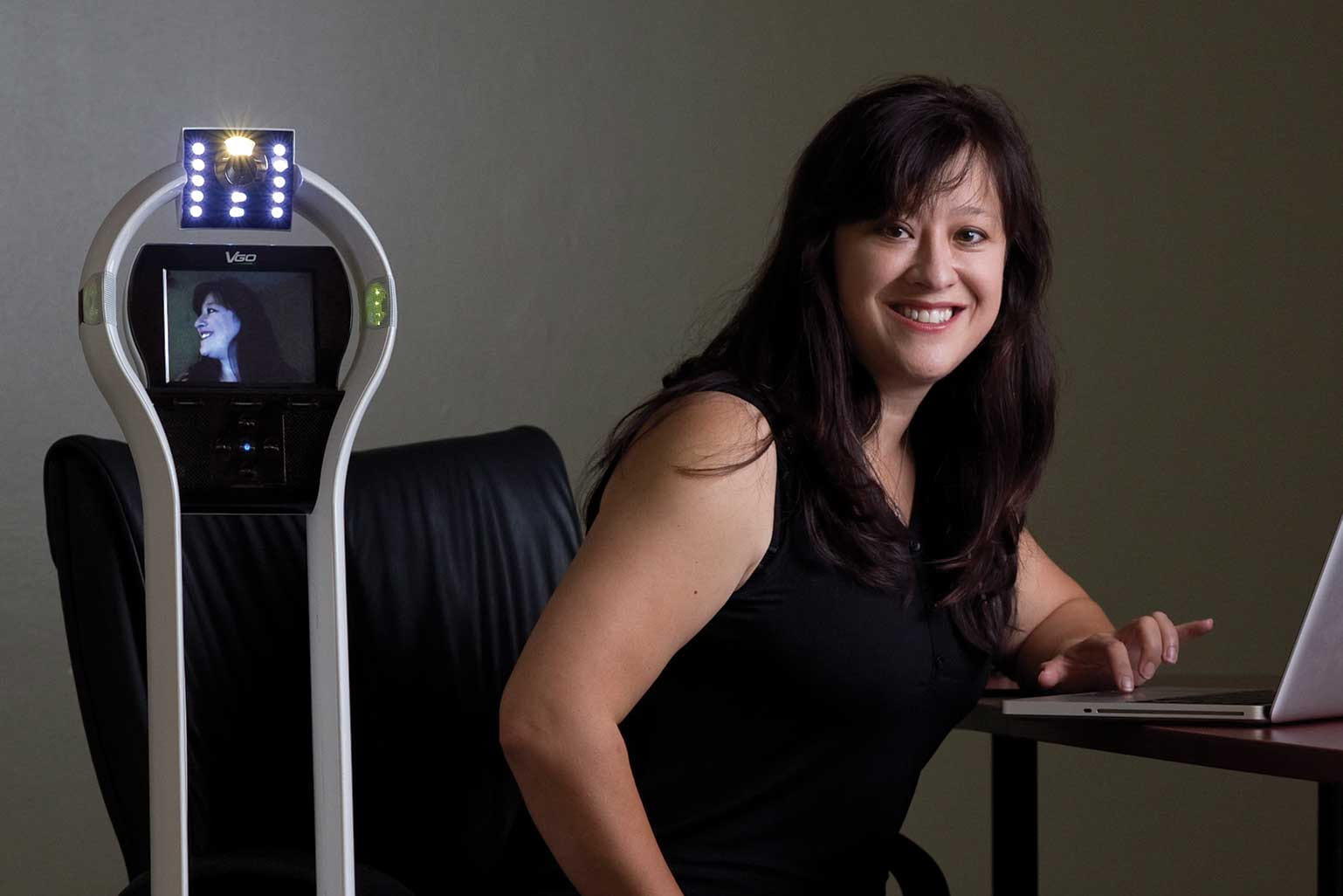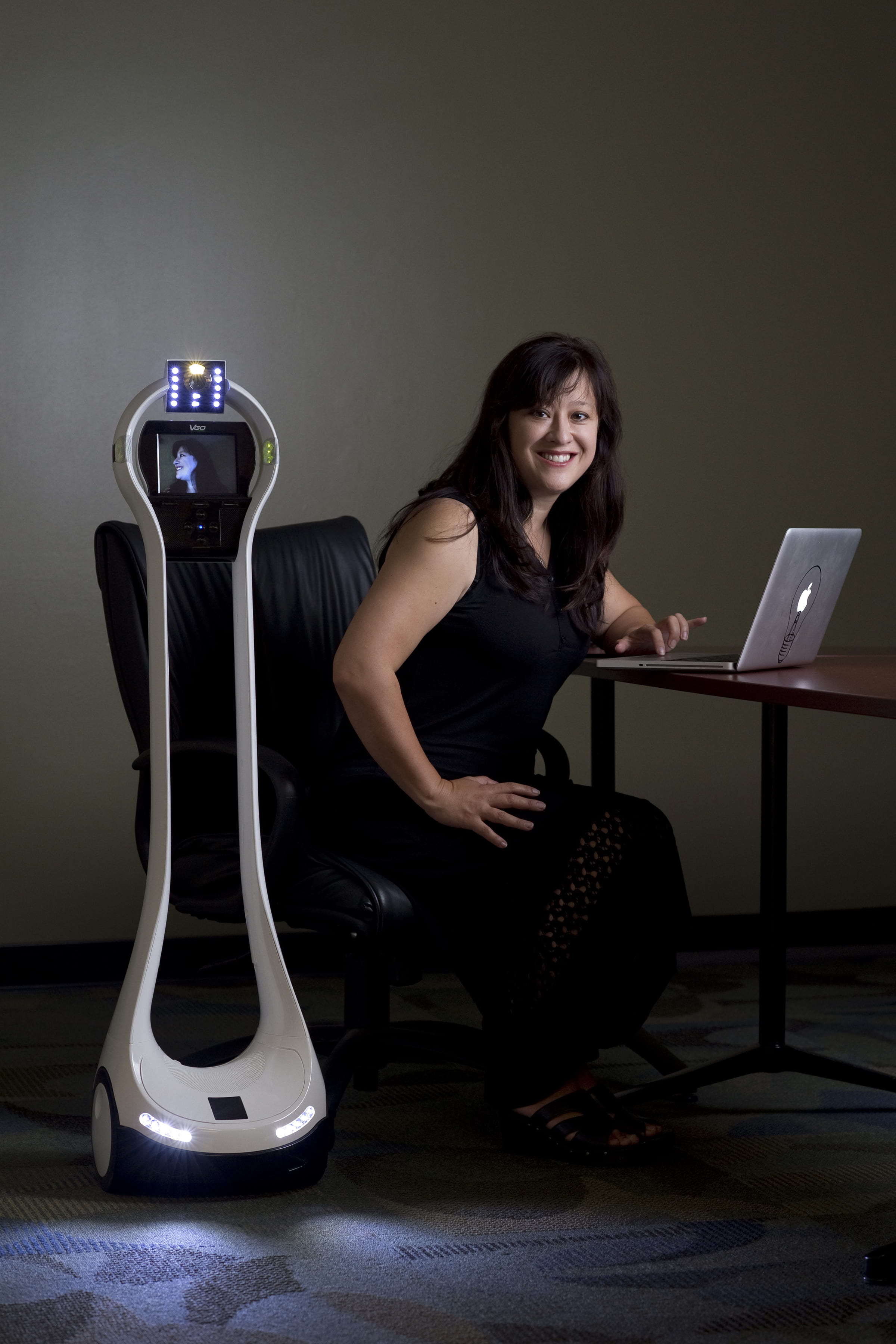Originally published in the Winter 2019 issue of UCI Magazine.
Connecting the Disconnected
In studying the effectiveness of telepresence robots in classrooms, a postdoctoral researcher who was homebound herself as a child finds that they can be life-changing
In Orange County, a 9-year-old named Kathy is able to attend school despite a disabling illness that confines her to home.
The same is true in New York, Maryland, Virginia and a few other U.S. locales, where an estimated 200 children go to class each day regardless of health issues.
Their technological hero? A telepresence robot – picture it as an iPad on a rolling stand – that goes to class in their place, allowing them to become virtual students who can make friends, listen to teachers and ask questions in real time.
“Telepresence robots can make quite a difference for students with an illness,” says UCI postdoctoral fellow Veronica Newhart, Ph.D. ’18, who’s studying the use of such technology to bring homebound students into the classroom – and the classroom into their homes. “It gives them the chance to be fully immersed in school activities.”
It’s a topic of particular interest to her. As a child, she was absent from school for large blocks of time because of a congenital heart condition. She hated the isolation she felt.
Consequently, Newhart was intrigued when she heard about telepresence robots, so named because they give users a presence at a remote location. Executives utilize them to participate in meetings virtually; physicians employ them to see far-flung patients.
And, more recently, homebound children have started using them to join their peers in classrooms. The robots, which stream live video of the remote students, foster social interaction and enable them to stay on top of their schoolwork.
Newhart became intrigued by the technology in 2009 but didn’t pursue it until she came to UCI five years ago to pursue a doctorate in education. Last year, she received a two-year postdoctoral fellowship in the National Institutes of Health-funded UCI Institute for Clinical & Translational Science training program.
Her project – which encompasses the School of Education, School of Medicine, Department of Informatics and Department of Cognitive Sciences – involves assessing the impact of telepresence robots on home-and hospital-bound students: Do they help kids engage with classmates, and does this contribute to improved health outcomes?
“Disconnected humans get depressed,” Newhart notes. “This use of technology as a way to include children who are otherwise isolated fascinates me.”

Classroom Integration
One of her goals is to update the educational services provided to homebound children. “The same system has been in place for more than 80 years,” she says. “A tutor makes home visits for four to five hours a week and brings over stacks of paperwork for the child to complete. The tutor is the child’s only connection to the classroom.”
While Newhart’s research on the use of telepresence robots hasn’t been completed, many observers – parents, teachers and administrators – report positive results.
Here’s how it works: Each unit is controlled by the remote user via a laptop and can travel from classroom to classroom. When stairs or other obstacles intervene, a helper gives the robot a ride. Built-in cameras and micro-phones allow homebound kids to participate in class. In addition to going to school, the robots sometimes go on field trips or to birthday parties or other off-campus sites.
For Kathy, who has use of a robot thanks to an anonymous donation to Newhart’s lab, the technology provides a way to stay in touch with friends. The third-grader has spinal muscular atrophy, a progressively debilitating disease that limits her mobility. She began using a telepresence robot as a kindergartner, and it’s now old hat for her and her classmates.
“She loves it,” says Genevieve Hosler, Kathy’s speech pathologist. “She loves the relationships she’s been able to form in the classroom.”
The unit helps Kathy academically, but its social and emotional impacts are equally significant.
“She’s a very extroverted girl, very social,” Hosler says. “She’s only able to go into class once a year, so maintaining classroom friendships is important to her. The robot really seems to give her a spark of excitement every day. And it’s comforting for her mom too.”
Students like Kathy are often overlooked, says Jacquelynne Eccles, an educational psychologist and Distinguished Professor of education at UCI. “There’s very little provision in the system for children who are isolated at home.”
One of Newhart’s mentors, Eccles is working with her on the project. “Many businesses use this technology. Why not use it for kids in school?” she asks. “The potential is huge because there are thousands and thousands of children who could benefit from this.”
Newhart has been interviewing students, parents, teachers and administrators as the trend expands nationwide. She targets kids who have cancer or other diseases that aren’t seen as “permanent” because she feels they’re a neglected segment of the school population.
“They don’t get much attention,” she says. “They don’t even qualify for disability services in some districts. If you’re a healthy child and you get cancer, you’re not eligible because the illness isn’t considered something permanent: Either you’re not going to make it or you’re in remission.”
That’s why her project is so important, Newhart says: “We need to collect data. More and more robots are being used in classrooms across the country, but we know very little formally about how it’s working. How do students learn? How does this technology help? How do you prepare teachers?”
“It seems to be extremely successful,” she says. “But some students don’t like it and turn the robot in. We need to know why that happens and be able to tell school districts which children may be the most successful utilizing it.”
Creating Empathy
The technology benefits others besides the individual user.
“It provides new avenues for kids in the classroom as well,” Eccles says. “Not only will they get to know this homebound child, but they will get to learn about sick children and what various illnesses can do. It will help them be empathetic to children who are going through these life situations.”
That aspect is clear in Kathy’s classroom, says Hosler, her speech pathologist.
“Whenever her teacher asks who wants to pair up with her on an assignment, everyone in the class raises their hands; they all want to,” she says. “It’s good for her and for them. They learn how to be compassionate and show how much they care.”
“Even the teachers are affected,” Hosler adds. “Being in constant contact with an ill student is an eye-opener for them too.”
Eccles, who specializes in child development and motivation, believes the robots will help dispel negative preconceptions.
“As a country, we isolate children from the illness experience by keeping the ill child at home,” she says. “This technology offers the opportunity to change that.”
Kathy and her third-grade classmates have already overcome those challenges. She has made friends with everyone and developed deeper relationships with a few peers.
“There are two children who have been very close to her since kindergarten,” Hosler notes. “One little boy has really taken her under his wing. They partner during activities and have done a lot of things together. It’s really sweet – just the two of them, having fun together.”



